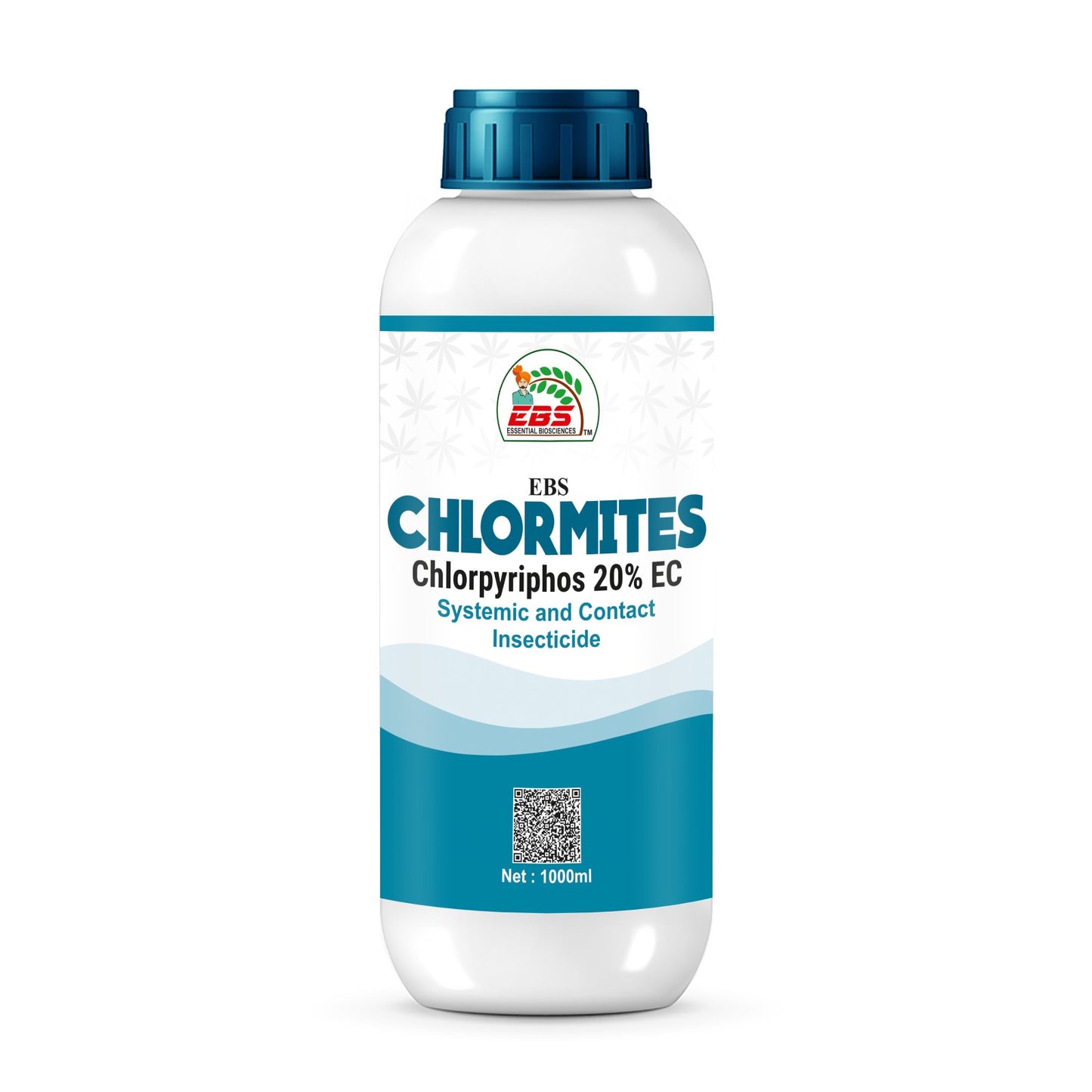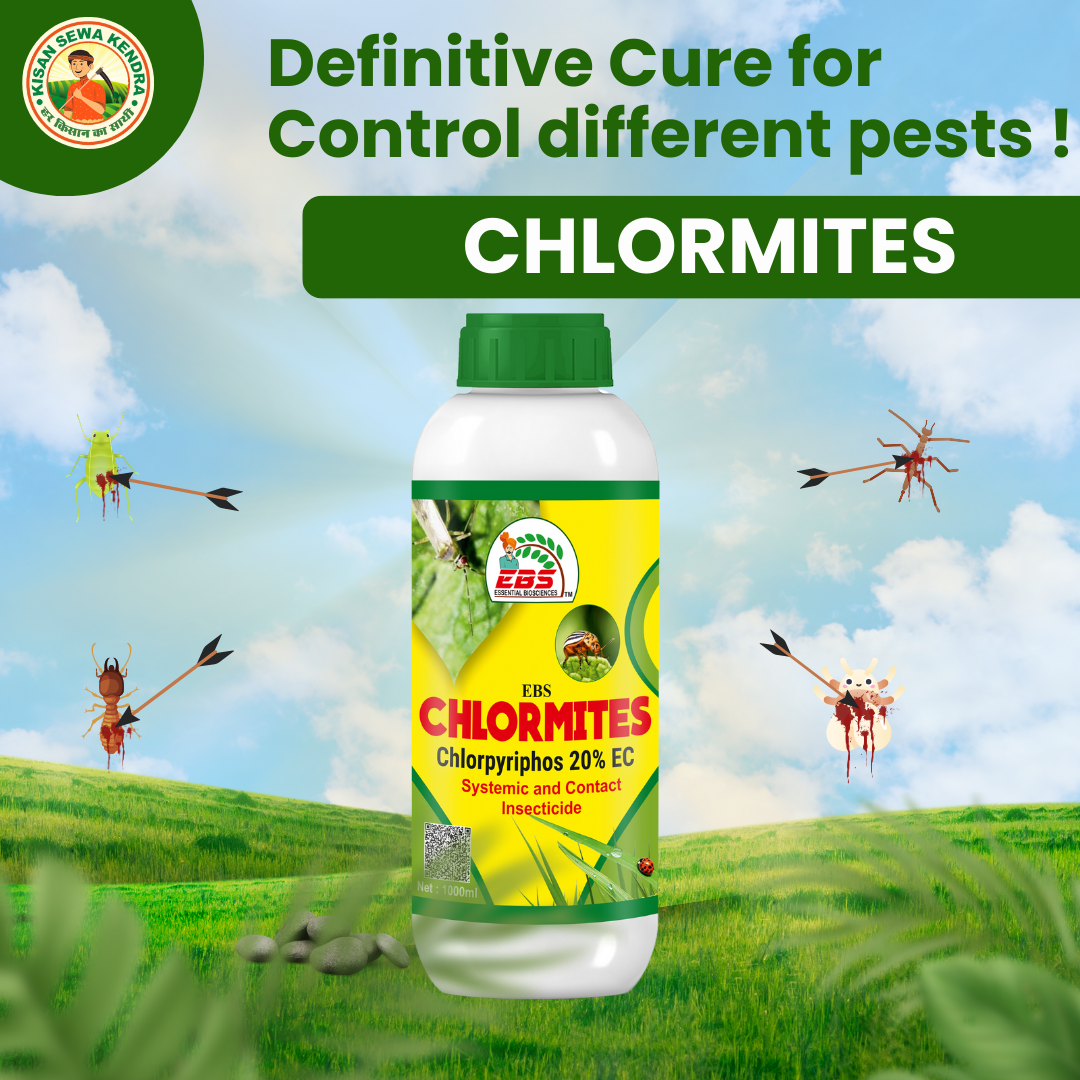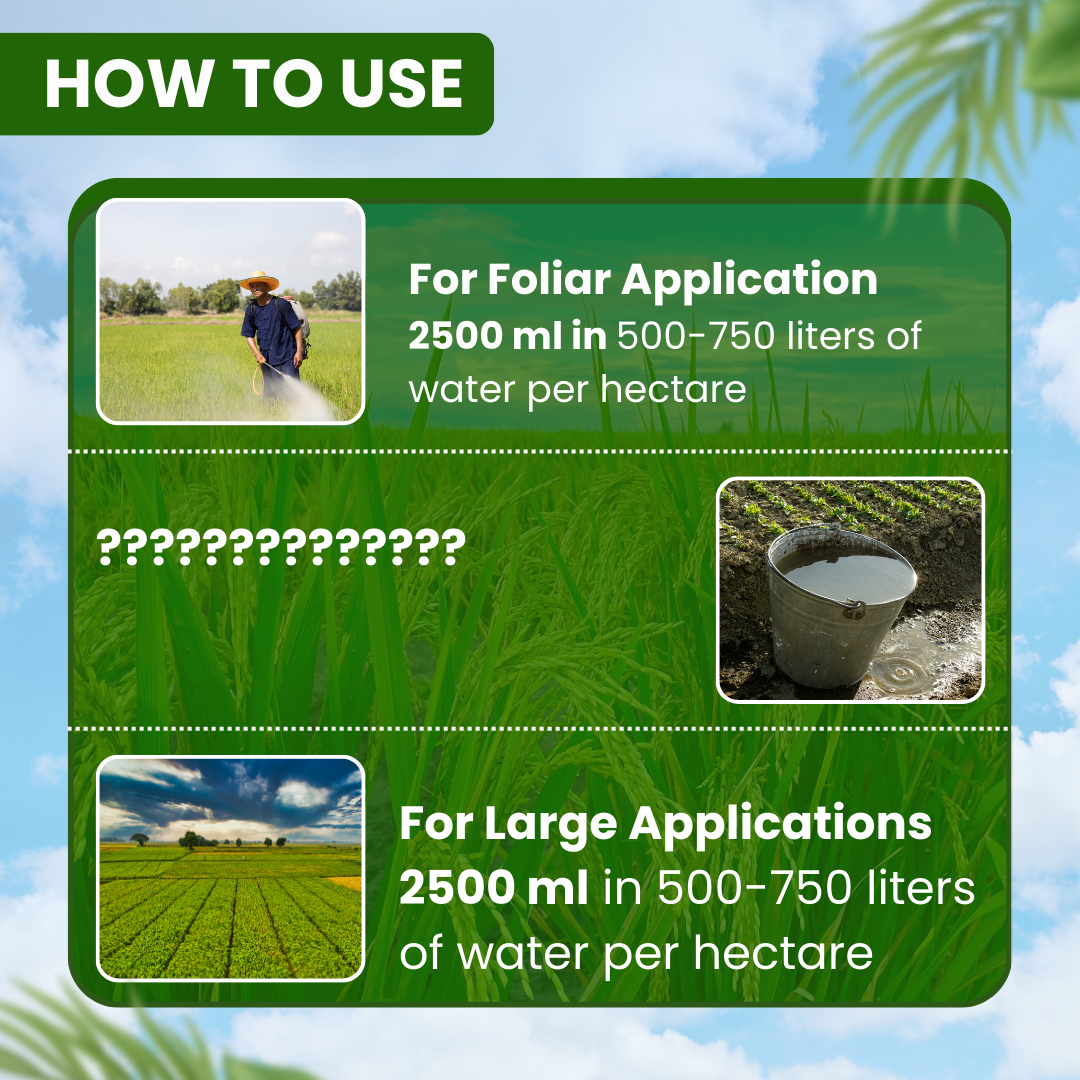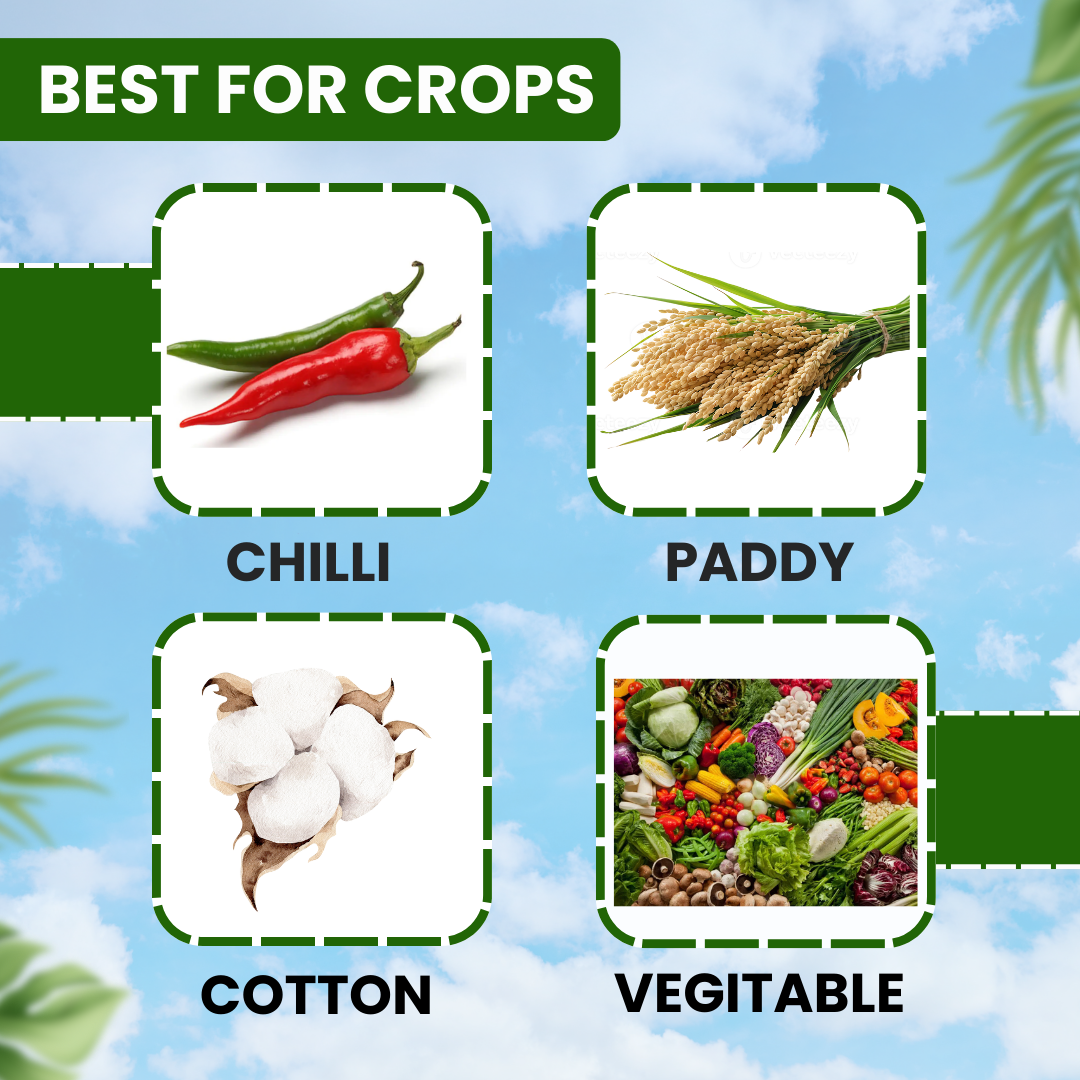
ESSENTIAL BIOSCIENCES
EBS Chlormites Chloropyriphos 20% EC
EBS Chlormites Chloropyriphos 20% EC
Couldn't load pickup availability
- Whatsapp or call for bulk orders: 9399022060
- Cash on Delivery Available for All customers in India
- Free Agri Expert Service Available
EBS Chlormites Chloropyriphos 20% EC
1. Product Overview:
Chlorpyriphos 20% EC (Emulsifiable Concentrate) is a broad-spectrum, organophosphate insecticide used for the effective control of chewing, sucking, and soil-dwelling pests in various crops. It acts as a contact, stomach, and fumigant poison, providing quick knockdown and long-lasting residual control. This insecticide is widely applied in agriculture, horticulture, and forestry to protect crops from a broad range of insect pests, including termites, borers, caterpillars, and sucking pests.
The EC formulation offers excellent dispersion, better coverage, and improved penetration, making it highly effective for both foliar and soil applications. Chlorpyriphos 20% EC is also extensively used for termite control in pre- and post-construction treatments.
2. Mode of Action:
Chlorpyriphos acts through multiple mechanisms, making it highly effective against pests:
-
Contact and stomach poison:
-
On contact or ingestion, it disrupts the nervous system of the pest.
-
-
Acetylcholinesterase (AChE) inhibition:
-
Chlorpyriphos blocks the enzyme acetylcholinesterase, which is essential for normal nerve function.
-
This leads to the accumulation of acetylcholine, resulting in continuous nerve impulses, causing paralysis and death of the pest.
-
-
Fumigant action:
-
When applied to the soil, Chlorpyriphos releases vapors that penetrate the termite galleries and burrows, making it highly effective for termite control.
-
-
Residual activity:
-
Provides long-lasting protection by remaining active on the crop surface or in the soil, controlling pests for several days or weeks.
-
3. Target Pests:
Chlorpyriphos 20% EC effectively controls a broad range of chewing, sucking, and soil pests, including:
-
Chewing pests:
-
Stem borers (Scirpophaga incertulas)
-
Root borers (Emmalocera spp.)
-
Shoot borers (Chilo spp.)
-
Leaf folder (Cnaphalocrocis medinalis)
-
Caterpillars (Spodoptera litura, Helicoverpa armigera)
-
Diamondback moth (Plutella xylostella)
-
-
Sucking pests:
-
Aphids (Aphididae)
-
Jassids (Empoasca spp.)
-
Whiteflies (Bemisia tabaci)
-
Thrips (Thripidae)
-
-
Soil-dwelling pests:
-
Termites (Isoptera)
-
Root grubs (Holotrichia spp.)
-
Cutworms (Agrotis ipsilon)
-
Wireworms (Elateridae)
-
-
Stored grain pests:
-
Red flour beetle (Tribolium castaneum)
-
Rice weevil (Sitophilus oryzae)
-
Lesser grain borer (Rhyzopertha dominica)
-
✅ Termite control:
Chlorpyriphos 20% EC is widely used for pre- and post-construction termite treatment in buildings, wood preservation, and soil treatment.
4. Crops:
Chlorpyriphos 20% EC is used in various agricultural and horticultural crops, including:
-
Field crops:
-
Cotton: Controls bollworms, aphids, jassids, and whiteflies.
-
Rice: Manages stem borers, leaf folders, and brown planthoppers.
-
Maize and corn: Protects against shoot borers and root grubs.
-
Sugarcane: Controls top borers and early shoot borers.
-
Pulses (chickpea, pigeon pea): Effective against pod borers and aphids.
-
Oilseeds (groundnut, mustard): Protects from termites, thrips, and leaf miners.
-
-
Vegetables:
-
Tomato, brinjal, and okra: Controls fruit borers, leaf miners, and whiteflies.
-
Cabbage and cauliflower: Effective against diamondback moths and caterpillars.
-
-
Fruits:
-
Mango: Controls hoppers and mealybugs.
-
Citrus: Manages aphids and leaf miners.
-
Grapes: Protects against thrips and mealybugs.
-
-
Plantation crops:
-
Tea and coffee: Effective against mites, caterpillars, and sucking pests.
-
Rubber and coconut: Controls termites and soil-dwelling insects.
-
-
Stored grains:
-
Used for protecting stored grains from beetles and weevils.
-
-
Non-crop use:
-
Pre- and post-construction termite treatment in buildings.
-
Wood preservation against borers and termites.
-
Public health: Used for mosquito and fly control.
-
5. Application and Dosage:
-
Foliar Spray:
-
Field crops: 2.0–2.5 ml per liter of water.
-
Fruits and vegetables: 1.5–2.0 ml per liter of water.
-
Plantation crops: 2.5–3.0 ml per liter of water.
-
-
Soil Drenching (for termite control):
-
Pre-construction: 4.0 liters of solution per square meter.
-
Post-construction: 5.0 liters of solution per square meter.
-
-
Frequency:
-
Apply at the first sign of infestation.
-
Repeat applications after 10–15 days, if necessary.
-
-
Pre-Harvest Interval (PHI):
-
Field crops: 21 days.
-
Vegetables: 7–10 days.
-
-
Recommended spray volume:
-
Field crops: 500–1000 liters of spray solution per hectare.
-
Orchards and plantations: 1000–1500 liters of spray solution per hectare.
-
6. Benefits:
-
Broad-spectrum insect control: Effective against both chewing and sucking pests, including termites.
-
Residual activity: Provides long-lasting protection, reducing the need for frequent applications.
-
Dual action: Works as both a contact and systemic insecticide, offering fumigant action.
-
Versatility: Suitable for use on multiple crops and in termite control.
-
Termite protection: Highly effective for pre- and post-construction termite treatment.
-
Cost-effective: Provides prolonged protection with fewer applications, reducing overall costs.
-
Rainfastness: Remains effective even after light rainfall.
7. Precautions and Safety:
-
Protective gear: Use gloves, masks, and goggles during handling and application.
-
Environmental protection: Avoid spraying near water bodies, as it is toxic to aquatic life.
-
Pollinator safety: Do not apply during flowering stages to protect bees and other pollinators.
-
Storage: Store in a cool, dry place away from food and animal feed.
-
Disposal: Dispose of empty containers responsibly.
-
Pre-harvest interval (PHI): Follow the recommended PHI to prevent pesticide residues.
8. Environmental Impact:
-
Toxicity:
-
Highly toxic to fish, bees, and aquatic organisms.
-
-
Persistence:
-
Chlorpyriphos degrades slowly, providing long residual activity.
-
-
Pollinator safety:
-
Avoid spraying during bloom periods to protect pollinators.
-
✅ Conclusion:
Chlorpyriphos 20% EC is a broad-spectrum organophosphate insecticide with contact, stomach, and fumigant action, making it highly effective against soil-dwelling, chewing, and sucking pests. Its long-lasting residual protection, combined with its versatility for crop and non-crop use, makes it a valuable tool for agricultural pest management and termite control.




This products has very good result.
Awesome Products with best prices
I recommend everyone to buy this product.
Best quality I have received from this.
Everyone Must Buy this product, best quality with good price.




